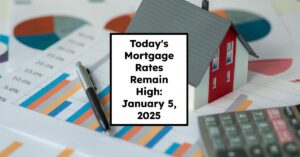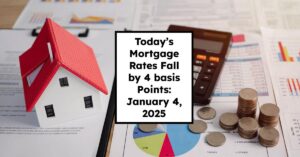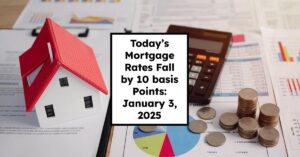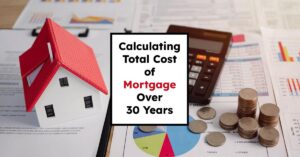Are you curious about the future of the housing market? What’s predicted for the housing market in 2025? Well, based on current trends and expert predictions, it seems that the housing market in 2025 will see a moderate rise in home sales, a stabilization of mortgage rates, and a slower increase in home prices compared to recent years.
While the market faced challenges in the previous couple of years, signs point to a more stable and potentially prosperous future for buyers and sellers alike.
I've been keeping a close eye on the housing market for a long time, and I find it fascinating how it ebbs and flows. It's a complex interplay of economic factors, demographics, and policy decisions. Let's dive into the specifics of what experts are saying about the housing market outlook for 2025 and beyond.
What’s Predicted for the Housing Market in 2025?
Home Sales on the Rise
The National Association of REALTORS® (NAR) predicts a notable increase in home sales in the coming years. Their economists believe the job market's improvement and the stock market's recent growth could motivate more people to enter the housing market.
According to NAR Chief Economist Lawrence Yun, the job market is expected to add close to 2 million new jobs in both 2025 and 2026. This job growth could translate to a stronger housing market. He believes that the worst of the recent housing market downturn might be over, as evidenced by the 3% year-over-year gain in pending home sales in September 2024, a good sign indeed.
Here’s a more detailed look at the sales projections:
| Year | Existing Home Sales (Year-over-Year Change) | New Home Sales (Year-over-Year Change) |
|---|---|---|
| 2025 | 9% increase | 11% increase |
| 2026 | 13% increase | 8% increase |
These figures suggest that demand for housing will continue to grow, although it's worth noting that these are just predictions, and unforeseen circumstances could alter the path. I personally believe that these projections are realistic, especially considering the pent-up demand we've seen in recent years. We have a huge population increase since 1995, and home sales have remained mostly flat, so it makes sense that there is a lot of demand waiting in the wings.
Mortgage Rates: A Look at Stability
The direction of mortgage rates significantly impacts the housing market. Over the past year, the average 30-year fixed-rate mortgage has fluctuated between 6.08% and 7.44% according to Freddie Mac.
However, Yun anticipates that mortgage rates will settle at the lower end of this range in 2025 and 2026. He expects that the Federal Reserve will continue to lower interest rates, but he cautions that mortgage rates might not follow the same trajectory.
One of the key factors limiting mortgage rate reductions is the large budget deficit. When the government borrows a lot of money, it reduces the amount of money available for mortgages, keeping rates from falling as quickly as some may hope.
Factors that could potentially lead to quicker declines in mortgage rates include:
- A reduction in the federal budget deficit.
- Easing of housing regulations that are currently hindering home builders.
- A substantial increase in the labor force to counter inflationary pressures.
If any of these factors were to gain more traction, we could potentially see a rapid decrease in mortgage rates. It's important to monitor these factors closely as they could impact the housing market in a significant way.
Home Price Appreciation: A Slower Pace
Homeowners have experienced remarkable gains in home equity over the past several years. These increases have been extraordinary and have resulted in a substantial widening of the wealth gap between homeowners and renters.
The median net worth for homeowners has increased by $147,000 in the past five years, while renters have seen a much smaller increase of only $10,000. This disparity is significant, and the trend cannot continue forever without causing serious economic and social divisions.
To keep the housing market more accessible, NAR predicts a slower pace of home price appreciation in the coming years. Yun believes that increased housing supply will play a crucial role in moderating price growth and making homeownership more attainable for a wider range of people.
Here's a look at the NAR's price forecasts:
| Year | Median Home Price | Year-over-Year Change |
|---|---|---|
| 2025 | $410,700 | 2% increase |
| 2026 | $420,000 | 2% increase |
These figures suggest that while home prices will continue to rise, it will be at a more manageable pace compared to recent years, which I think is a good thing. It will help make the market more inclusive and less volatile. I believe that a healthier and more sustainable housing market is one that has moderate price increases that keep pace with income growth.
The Changing Face of Homebuyers
NAR's 2024 Profile of Home Buyers and Sellers has shed light on some interesting shifts in the demographic makeup of homebuyers.
Here are some of the key takeaways:
- More All-Cash Buyers: All-cash buyers are making up a bigger portion of the housing market, reaching 26% of sales in the past year. This is driven by the considerable housing equity that many homeowners have gained over the past several years.
- Older First-Time Buyers: The median age of a first-time home buyer is now 38, a record high. This means that more people are waiting longer to purchase their first home, likely due to factors like rising home prices and a longer time frame needed to save for a down payment. This also shows that the “bank of mom and dad” is playing a larger role. Twenty-five percent of first-time buyers used a gift or loan from a family member or friend to purchase their home.
- The Allure of City Centers: While the pandemic caused a shift towards the suburbs, there's been a noticeable resurgence in interest in urban living, with the largest increase in a decade. I think this is interesting as it goes against the grain of what we saw during the pandemic.
- Multigenerational Households on the Rise: Multigenerational households—those with multiple generations living under one roof—have surged to an all-time high of 17%. The main reason for this trend is the desire to reduce housing costs by combining incomes. There has also been an increase in adult children moving back home, and an increase in the need to care for aging parents. It makes sense that with the cost of living going up and fewer people being able to afford housing on their own, they would want to pool resources.
- Single Women Leading the Charge: Single women continue to be a driving force in the housing market, representing 24% of home purchases in the past year, compared to only 11% for single men. The decline in marriage rates has pushed more people to enter the housing market independently.
These shifts in buyer demographics suggest that the housing market is becoming increasingly diverse, which could have a lasting impact on the overall housing landscape and future needs.
Recommended Read:
Housing Market: Homeowner’s Wealth Jumps $150,000 in 5 Years
Challenges and Opportunities in the 2025 Housing Market
While the predictions for the housing market in 2025 appear to be positive overall, it's essential to acknowledge some of the challenges and opportunities that lie ahead:
- Affordability: Housing affordability remains a major hurdle for many Americans, particularly first-time homebuyers. The combination of rising home prices and mortgage rates makes it difficult for some people to purchase a home.
- Inventory Shortages: While inventory levels have been steadily increasing, there are still shortages in certain areas, particularly those with strong job markets and desirable amenities.
- Interest Rate Volatility: The path of interest rates remains uncertain. If rates rise unexpectedly, it could put a damper on buyer activity and potentially lead to a cooling-off period in the market.
- Economic Uncertainty: The overall economic climate remains a cause for concern. A potential recession or other economic downturn could significantly impact the housing market.
- Regulatory Environment: Changes in local, state, and federal regulations regarding housing construction and development could influence the availability and affordability of homes.
Despite these challenges, the housing market also presents some opportunities:
- Rising Demand: The underlying demand for housing is expected to remain strong in the coming years, fueled by demographic trends and continued job growth.
- Investment Potential: Housing has historically been a solid investment, and many believe that it will continue to provide a good return in the future. I agree with this assessment, especially considering the rising demand we're seeing and the relative stability of the market.
- Innovation: Technological advancements are creating new opportunities in the housing industry, from virtual tours and online marketplaces to smart home technology and 3D printing.
- Adaptability: The housing industry has proven its ability to adapt to changing circumstances. I've seen this firsthand in my experience, and I anticipate that the sector will continue to evolve and find creative solutions to address the challenges and opportunities ahead.
Recommended Read:
In conclusion, the outlook for the housing market in 2025 is mixed. We anticipate a moderate increase in home sales, a stabilization of mortgage rates, and a slower pace of price appreciation. However, challenges like affordability, inventory shortages, and economic uncertainty still need to be addressed.
I hope this overview provides some insights into the potential trajectory of the housing market in 2025. As always, it's important to do your research, consult with professionals, and carefully consider your own circumstances before making any real estate decisions.
Partner with Norada, Your Trusted Source for Turnkey Investment Properties
Discover high-quality, ready-to-rent properties designed to deliver consistent returns. Contact us today to expand your real estate portfolio with confidence.
Reach out to our investment counselors:
(949) 218-6668 | (800) 611-3060
Also Read:
- Housing Market Forecast for the Next 2 Years: 2024-2026
- 87% of Metros in America Posted Home Price Gains in Q3 2024
- Housing Market Predictions for Next Year: Prices to Rise by 4.4%
- Housing Market Predictions for the Next 4 Years: 2024 to 2028
- Real Estate Forecast Next 5 Years: Top 5 Predictions for Future
- Real Estate Market Predictions 2025: What to Expect
- Is the Housing Market on the Brink in 2024: Crash or Boom?
- 2008 Forecaster Warns: Housing Market 2024 Needs This to Survive
- Real Estate Forecast Next 10 Years: Will Prices Skyrocket?
- Housing Market Predictions for Next 5 Years (2024-2028)











